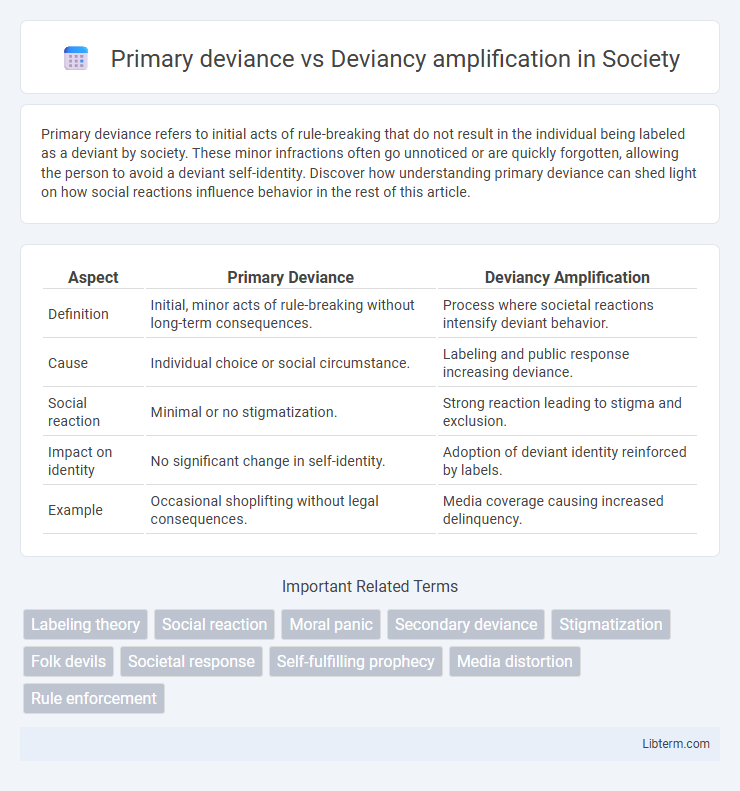Primary deviance refers to initial acts of rule-breaking that do not result in the individual being labeled as a deviant by society. These minor infractions often go unnoticed or are quickly forgotten, allowing the person to avoid a deviant self-identity. Discover how understanding primary deviance can shed light on how social reactions influence behavior in the rest of this article.
Table of Comparison
| Aspect | Primary Deviance | Deviancy Amplification |
|---|---|---|
| Definition | Initial, minor acts of rule-breaking without long-term consequences. | Process where societal reactions intensify deviant behavior. |
| Cause | Individual choice or social circumstance. | Labeling and public response increasing deviance. |
| Social reaction | Minimal or no stigmatization. | Strong reaction leading to stigma and exclusion. |
| Impact on identity | No significant change in self-identity. | Adoption of deviant identity reinforced by labels. |
| Example | Occasional shoplifting without legal consequences. | Media coverage causing increased delinquency. |
Understanding Primary Deviance: Definition and Examples
Primary deviance refers to initial acts of rule-breaking or norm violations that do not result in the individual being publicly labeled as deviant. Common examples include minor theft, underage drinking, or first-time drug use, which often go unnoticed or are temporarily excused by society. Understanding primary deviance is crucial for analyzing how unpunished or unnoticed behaviors can escalate or lead to further deviant actions without impacting an individual's self-identity.
What is Deviancy Amplification? Key Concepts
Deviancy amplification refers to the process by which societal reactions to an initial act of deviance result in an increase in the deviant behavior or the visibility of the deviance itself. Key concepts include the role of media exaggeration, moral panic, and law enforcement responses that label individuals or groups, often escalating public fear and deviance rates. This feedback loop highlights how social control mechanisms can inadvertently reinforce and expand deviant activities beyond the original primary deviance.
Origins and Theoretical Backgrounds
Primary deviance originates from labeling theory, describing initial acts of rule-breaking that do not affect an individual's self-identity or social status. Deviancy amplification, rooted in sociological theories of moral panic, explains how societal reactions to primary deviance can escalate deviant behavior by reinforcing negative labels and marginalization. The interplay between these concepts highlights the role of social responses and media in transforming minor infractions into more entrenched criminal identities.
Primary Deviance in Everyday Life
Primary deviance refers to the initial acts of rule-breaking that do not result in a person being labeled as deviant or affecting their self-identity. These minor transgressions, such as skipping school or petty theft, are often overlooked or justified as situational lapses in everyday life. Understanding primary deviance is crucial for analyzing how societal reactions can escalate behaviors into secondary deviance through stigmatization and deviancy amplification.
The Role of Media in Deviancy Amplification
Primary deviance refers to the initial act of rule-breaking that does not result in the individual being labeled as a deviant, whereas deviancy amplification describes the process where societal reaction, especially media coverage, intensifies and escalates deviant behavior. The role of media in deviancy amplification involves sensationalizing minor offenses, framing them as widespread social problems, which influences public perception and prompts harsher social and legal responses. This media-driven cycle exacerbates deviance by reinforcing negative stereotypes and increasing social exclusion for those labeled as deviant.
Social Reactions and Labeling Theory
Primary deviance refers to initial acts of rule-breaking that do not result in a person being labeled as deviant, while deviancy amplification occurs when social reactions to deviance reinforce and escalate the deviant behavior. According to Labeling Theory, societal responses and negative labeling can marginalize individuals, leading to secondary deviance and the internalization of a deviant identity. Social reactions play a critical role in transforming occasional misconduct into a chronic deviant status through stigmatization and increased surveillance.
Differences Between Primary Deviance and Deviancy Amplification
Primary deviance involves initial acts of rule-breaking that are often minor and not publicly labeled, while deviancy amplification refers to the social reaction that escalates deviant behavior through increased stigmatization and enforcement. Primary deviance typically occurs without a lasting deviant identity, whereas deviancy amplification results in the person being publicly labeled, reinforcing further deviance. The key difference lies in the social response: primary deviance is the original act, and deviancy amplification is the process where societal reaction intensifies deviance and commits individuals to a deviant identity.
Effects on Individuals and Society
Primary deviance involves minor norm violations that individuals or society often overlook or dismiss, causing limited direct stigma for the person involved. Deviancy amplification occurs when societal reactions, such as media labeling or law enforcement scrutiny, intensify the deviant behavior, leading to increased social exclusion and internalization of a deviant identity by the individual. This process escalates social control measures and can reinforce a deviant subculture, profoundly impacting community cohesion and individual self-concept.
Case Studies: Real-World Implications
Primary deviance refers to initial acts of rule-breaking that go unnoticed or are minimally labeled, whereas deviancy amplification describes how societal reaction can escalate deviant behavior by reinforcing a deviant identity. Case studies such as the Mods and Rockers conflict in 1960s Britain illustrate how media portrayal intensified public fear and police intervention, exacerbating youth violence beyond the initial deviant acts. Real-world implications highlight the role of moral panics in shaping criminal justice policies, often leading to harsher punishments and the marginalization of already vulnerable groups.
Addressing Deviance: Prevention and Intervention Strategies
Primary deviance involves initial acts of rule-breaking that do not affect an individual's self-identity, while deviancy amplification refers to the process where societal reaction increases deviance through labeling and stigmatization. Prevention strategies targeting primary deviance emphasize early intervention, education, and community support to reduce initial rule-breaking behaviors. Intervention approaches addressing deviancy amplification focus on minimizing negative societal reactions, promoting restorative justice, and providing support systems that prevent the escalation of deviant behavior.
Primary deviance Infographic

 libterm.com
libterm.com